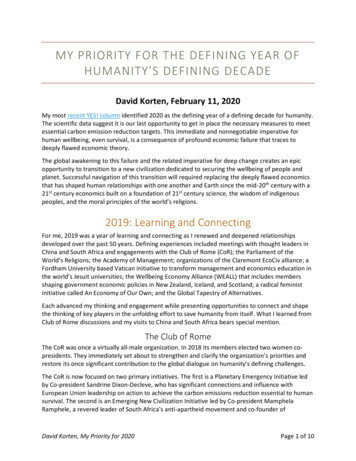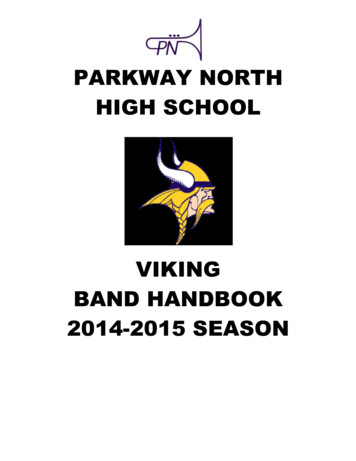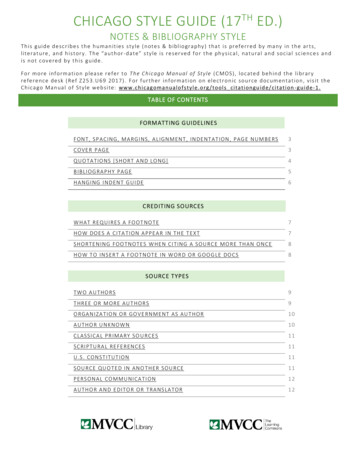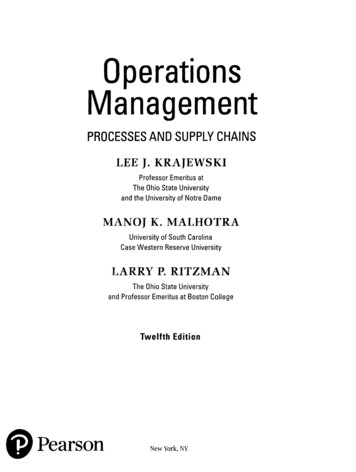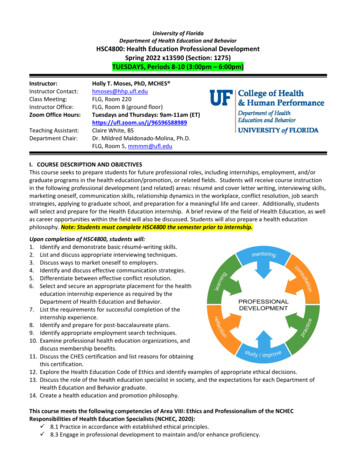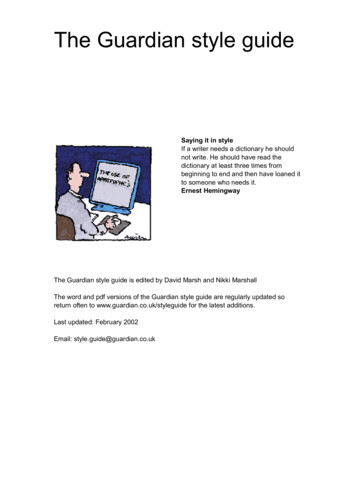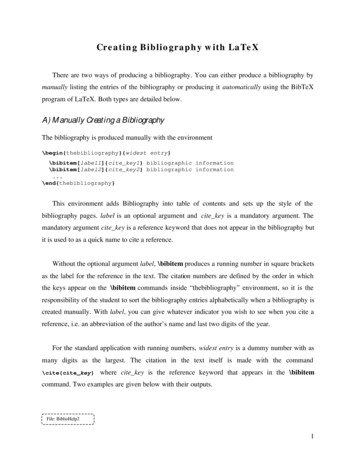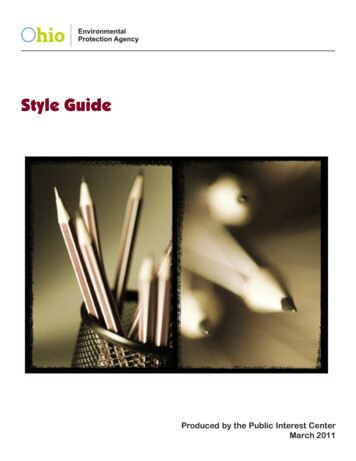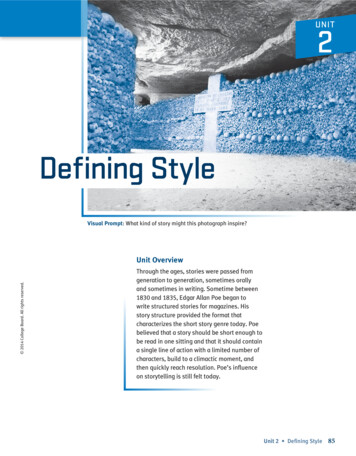
Transcription
UNIT2Defining StyleVisual Prompt: What kind of story might this photograph inspire? 2014 College Board. All rights reserved.Unit OverviewThrough the ages, stories were passed fromgeneration to generation, sometimes orallyand sometimes in writing. Sometime between1830 and 1835, Edgar Allan Poe began towrite structured stories for magazines. Hisstory structure provided the format thatcharacterizes the short story genre today. Poebelieved that a story should be short enough tobe read in one sitting and that it should containa single line of action with a limited number ofcharacters, build to a climactic moment, andthen quickly reach resolution. Poe’s influenceon storytelling is still felt today.Unit 2 Defining Style85
Defining Style2GoalS:Contents To identify specific elementsof an author’s styleActivities To review and analyzeelements of fiction and writea short story2.1Previewing the Unit. 882.2Genre Study: Reviewing the Elements of a Story. 89 To analyze syntacticalstructure and use clauses toachieve specific effects2.3Experimenting with Point of View. 912.4Language and Writer’s Craft: Writer’s Style . 94 To develop close readingskills2.5 The Meaning of Imagery and Symbols. 96Poetry: “Fire and Ice,” by Robert Frost To identify cinematictechniques and analyzetheir effectsacademic vocabularyverifycommentarytextual commentarytextual evidenceLiterary Termsstylesymbolfigurative languageliteral languagetoneironyallusionsimagerycinematic techniquesmain ideathemebiographyautobiographymood2.6 Shared Gifts: Introducing Irony. 98 Short Story: “The Gift of the Magi,” by O. Henry(William Sidney Porter)Introducing the Strategy: DiffusingIntroducing the Strategy: SIFT2.7 Close Reading of a Short Story. 106Short Story: “The Stolen Party,” by Liliana Heker(translated by Alberto Manguel)Introducing the Strategy: Questioning the Text2.8 Introducing a Story of Revenge.1142.9 Irony in the Vaults.116Short Story: “The Cask of Amontillado,”by Edgar Allan Poe2.10 Connecting Symbolism to Meaning. 124Poetry: “A Poison Tree,” by William BlakeEmbedded Assessment 1:Writing a Short Story. 1262.11 Previewing Embedded Assessment 2:Thinking About Style. 1282.12Working with Cinematic Techniques. 1312.13 Film in Context: An Authorial Study. 133Biographical Essay: “Tim Burton: Wickedly Funny,Grotesquely Humorous”86SpringBoard English Language Arts Grade 9 2014 College Board. All rights reserved.UNIT
2.14 Setting the Mood and Understanding Tone:Wonka Two Ways. 136Novel: Excerpts from Charlie and the ChocolateFactory, by Roald Dahl*Film: Charlie and the Chocolate Factory (2005),directed by Tim BurtonLanguage and Writer’sCraft Writer’s Style (2.4) Sentence Types (2.7) CombiningSentences (2.14) Transitions (2.20)2.15 Revisiting Wonka: Thinking About Effect. 144*Film: Charlie and the Chocolate Factory (2005),directed by Tim Burton2.16 More About Stylistic Effect. 145*Film: Charlie and the Chocolate Factory (2005),directed by Tim Burton2.17 Interpreting Style: Tim Burton’s Edward Scissorhands. 148*Film: Edward Scissorhands (1990),directed by Tim Burton2.18 Analyzing Burton’s Style: Supporting with Textual Evidence. 150*Film: Edward Scissorhands (1990),directed by Tim Burton 2014 College Board. All rights reserved.2.19 Analyzing Burton’s Style: Explaining with Commentary. 154*Film: Edward Scissorhands (1990),directed by Tim Burton2.20 Analyzing Burton’s Style: Bringing to Closure. 157*Film: Edward Scissorhands (1990),directed by Tim Burton2.21 Analyzing Burton’s Style: Writing the Analytical Paragraph. 160*Film: Edward Scissorhands (1990),directed by Tim Burton2.22 Independent Viewing. 1622.23Planning a Draft. 164Embedded Assessment 2:Writing a Style Analysis Essay. 167*Texts not included in these materials.Unit 2 Defining Style87
ACTIVITY2.1Previewing the UnitLearning Strategies:Close Reading, KWHL, Markingthe Text, Skimming/Scanning,SummarizingLearning Targets Connect prior knowledge to the genre of short story. Analyze the skills and knowledge needed to complete Embedded Assessment 1successfully.Making ConnectionsMy NotesIn this unit, you will build on your experiences reading and writing short stories.You will study elements of short stories, not only to write your own originalstories, but also to understand how to analyze and write about literature. As youstudy poetry, short stories, and film, you will analyze the elements that make upa writer’s or director’s style. You will also examine the ways in which directors ofvisual media manipulate their audiences’ reactions through the unique stylisticchoices they make in creating their products.Essential QuestionsBased on your current knowledge, write your answers to these questions.1. What makes a good story?2. What are the elements of a style analysis?Look at the list of Academic Vocabulary and Literary Terms on the Contents page.Use a QHT or other strategy to analyze and evaluate your knowledge of thosewords. Use your Reader/Writer Notebook to make notes about meanings you knowalready. Add to your notes as you study this unit and gain greater understanding ofeach of these words.Unpacking Embedded Assessment 1Read the following assignment for Embedded Assessment 1:IndependentReading LinkThe focus of this unit is onshort stories. As you beginyour study of the unit, choosethree to four short stories toread independently. Make aplan for reading in which youdecide which authors andkinds of stories you like, aswell as a regular time you willset aside for reading. To getstarted thinking about theshort story genre and the ideaof style, answer the EssentialQuestions on this page.88Your assignment is to write an original narrative from real or imaginedexperiences or events. Your story must include a variety of narrativetechniques—such as foreshadowing, point of view, figurative language,imagery, symbolism, and/or irony—as well as effective details and a wellstructured sequence of events.With your class, create a graphic organizer to identify the skills and knowledge youwill need to accomplish this task and plan how you will acquire them to completethe assignment. To help you complete your graphic organizer, be sure to review thecriteria in the Scoring Guide on page 127.SpringBoard English Language Arts Grade 9 2014 College Board. All rights reserved.Developing Vocabulary
Genre Study: Reviewing theElements of a StoryLearning Targets Identify the elements of a short story and place them on a plot diagram. Make a plan for my independent reading during this unit. Create characters and conflicts for an original short story.ACTIVITY2.2Learning Strategies:Graphic Organizer, Markingthe Text, RereadingElements of a Short Story/NarrativeA short story is a form of narrative. Narratives include made-up stories—fiction—as well as real-life stories—nonfiction. A short story is a work of fiction, and thisgenre includes certain literary elements.My NotesWork with a partner and brainstorm in the My Notes section a list of elements of aplot. As a class, you will create a complete list of the literary terms associated withcreating and analyzing the plot of any narrative.Elements of PlotAfter discussing the meanings of terms about plot, place the elements of plot thatyou identified in the appropriate place on the blank story diagram below. 2014 College Board. All rights reserved.Plot DiagramUnit 2 Defining Style89
ACTIVITY 2.2continuedGenre Study: Reviewing theElements of a StoryAcademic VocabularyTo verify is to proveor confirm that somethingis true.WordConnectionsRoots and AffixesThe word irony has the Greekroot -eiron-, referring tosomeone who, in speaking,conceals true thoughts orfeelings.You may have brainstormed these additional elements of short stories. Withyour partner, discuss and then verify definitions using appropriate references,such as a dictionary.Characters—Main character or protagonist—Minor characters—Theme—Literary elements:My Notes Point of View— Irony— Imagery— Figurative Language— Symbol—Planning a StoryIn preparation for writing your own short story, brainstorm what you mightinclude in a short story. Your ideas could become the basis of your short story forEmbedded Assessment 1.1. Think about a character for your short story. Create a name and two importantcharacteristics of your character’s personality.2. An essential element of a short story’s plot is conflict. Think about possibleconflicts that you could use to develop a plot, and use the following prompts toto think about both an internal and an external conflict for your character.Character Name:Characteristic 1:Characteristic 2:External conflict: versusInternal conflict:90SpringBoard English Language Arts Grade 9 2014 College Board. All rights reserved. Allusion—
Experimenting with Point of ViewLearning Targets Identify and discuss the effect of the point of view from which a story is told. Choose an appropriate point of view for an original short story.ACTIVITY2.3Learning Strategies:Close Reading, RearrangingComparing Points of ViewExamine and discuss the differences among the following three points of view:My NotesFirst Person:Third-Person Limited:Third-Person Omniscient:Determine which point of view is modeled in the passages below. Then try to definethe important characteristics of that point of view.1. I ran into my ex-girlfriend Lisa. I did not want to see her again. She always wantsto get back with me, and I just want to move on. 2014 College Board. All rights reserved.2. John was pained to see Lisa coming around the corner. He worried that shemight still want to get back together.3. John ran into Lisa at the convenience store. He mistook her good humor andfriendliness as a desire to get back together with him. Lisa smiled at John,happy to tell him that she was newly engaged.WordConnectionsRoots and AffixesNow, use your understanding of point of view to transform each excerpt on thenext page into the other two points of view. Work in pairs to discuss and transformthe texts. After you and your partner have transformed each passage, take turns readingyour rewrites to each other. Provide feedback to each other by studying the rewrites and answering thisquestion: What parts of the response make it the correct point of view?The word omniscient has twoLatin roots: omni-, meaning“all” or “everything,” andsci-, meaning “knowing” or“knowledge.”The root omni- also occurs inomnivorous and omnipotent.The root sci- occurs in science,conscious, conscience, andconscientious.Unit 2 Defining Style91
ACTIVITY 2.3Experimenting with Point of ViewcontinuedMy NotesExcerpt 1Third-Person Limited: The city skyline covered the horizon. From the balcony of herhigh-priced apartment that she shared with Jake, Sarah looked out and wondered ifshe was happy. Something seemed to be missing. Jake looked over to her, and Sarahlooked away quickly, hoping that she had not given away her private thoughts.First Person:Third-Person Omniscient:Excerpt 2Third-Person Omniscient:The robber looked over his potential prey for the evening. They all seemed likeeasy marks to him. Who would it be, he wondered. Feeling someone’s eyes on herpocketbook, Jane held it closer to her body. She would not be robbed again, afterthat last time.Third-Person Limited:92SpringBoard English Language Arts Grade 9 2014 College Board. All rights reserved.First Person:
ACTIVITY 2.3continuedCheck Your UnderstandingPoint of view is an element of style that authors consciously choose. With anotherstudent, answer the following questions regarding point of view: Which point of view gives the most information about the actions and feelings ofthe characters? Why? Which is most limited? Why? Why would an author choose to tell a story in first person? In third-personlimited? In third-person omniscient?My NotesWriting a Short StoryWriting Prompt: Return to the conflicts and characters that you created in Activity 2.2.Write an opening to a story that presents the character, the conflict (s), and/or thesetting using the point of view that you think would be best to narrate the story. Besure to include the following: a central conflict that will drive the events of the story and develop thecharacter an internal or external conflict for the main character a consistent point of view an introduction to the main character through description of appearance,actions, and voice. 2014 College Board. All rights reserved.Once you have written the opening, return to the plot diagram and use it to outlinea plan of rising action for your story. What sequence of events could occur to moveyour character to the climax of the story?Unit 2 Defining Style93
ACTIVITY2.4Language and Writer’s Craft:Writer’s StyleLearning Strategies:Marking the Text, DraftingGRAMMAR USAGEPunctuationNote the semicolon inthe third sentence ofPoe’s opening. Poe usesa semicolon to join twoindependent clauses. Asemicolon may also be usedto join elements of a serieswhen items in the seriesalready have commas.Learning Targets Make inferences about the effect a writer achieves by using specific sentencetypes and patterns. Emulate an author’s style by writing a story opener in that style.Writer’s StyleAs you remember from Unit 1, a writer’s style or voice is created by elements suchas diction, syntax, and imagery, as well as point of view. Review these elements tobe sure you understand and can define them.Certain stories grab the reader’s attention and never let go until the story ends.Read the opening paragraph from “The Gift of the Magi” by O. Henry from this unit. Circle the images that stand out in the passage. Underline the sentence fragments, and annotate the text to describe what effectthe author creates with these fragments.“One dollar and eighty-seven cents. That was all. And sixty cents of it was in pennies.My NotesPennies saved one and two at a time by bulldozing the grocer and the vegetable manand the butcher until one’s cheeks burned with the silent imputation of parsimony thatsuch close dealing implied. Three times Della counted it. One dollar and eighty-sevenIn contrast, examine the opening of the short story, “The Cask of Amontillado,”which you will be reading soon. After reading this passage, think about the effectof the diction, the syntax, and the point of view. What impression of the narratordoes Edgar Allan Poe create?“The thousand injuries of Fortunato I had borne as I best could, but when he venturedupon insult, I vowed revenge. You, who so well know the nature of my soul, will notsuppose, however, that I gave utterance to a threat. At length I would be avenged; thiswas a point definitively settled—but the very definitiveness with which it was resolvedprecluded the idea of risk.”Notice how the syntax affects the pacing of the action. Which story seems to set afaster pace or seems to set the action of the story in motion more quickly?Poe uses long compound and complex sentences, while O. Henry uses sentencefragments for effect. A sentence fragment is a group of words that is grammaticallyincomplete and cannot stand alone. Writers change their sentence structure—theiruse of phrases, clauses, and different types of sentences—to create certain effects.94SpringBoard English Language Arts Grade 9 2014 College Board. All rights reserved.cents. And the next day would be Christmas.”
ACTIVITY 2.4continuedEmulating a Writer’s StyleEvery writer has a unique style. You will develop your own style as you developyour writing skills. One way to begin experimenting with style is to emulateanother writer. To emulate a writer is to imitate the writer’s style, including how heor she constructs sentences. For example, here is an emulation of Edgar Allan Poe’sopening paragraph from the preceding page:The deliberate rudeness of Lydia I had suffered silently, but when her actionsbordered on bullying, I promised myself payback. You, who know my cautious,careful manner, do not think, however, that I indicated anything about my plansto Lydia. Eventually, I would get revenge, this I knew—but I would do so withoutany risk of blame.Writing Prompt: Choose one of the short story opening paragraphs in this activityand emulate that writer’s style to write an original story opening. Be sure to dothe following: Emulate the style of the author you chose. Introduce a character, a setting, and/or a conflict in the opening. Vary your sentence types to create an effect (or to affect the pacing ofthe narrative).Literary TermsStyle refers to the distinctiveway a writer uses language,characterized by elementsof diction, syntax, imagery,organization, and so on.IndependentReading LinkAs you read the short storiesyou have chosen, makenotes about the writer’sstyle for each story, basedon what you have learnedabout authors’ styles thusfar. Examine the storyopening for ideas aboutwriting your own story.Check Your Understanding 2014 College Board. All rights reserved.After you have completed your emulation of a story opening, reflect on youropening by asking and answering these questions:a. What effect did I intend to create?b. How do the sentences of my story opening achieve that effect?c. Does the story opening represent the style of the writer I am trying to emulate?My NotesRemember that a story’s beginning, the exposition, has several purposes: To describe the setting To introduce the characters and/or narrator telling the story To introduce the conflict in the story and set the plot in motionRevise your story opening based on your reflection, and expand your opening toinclude more elements of story exposition. You may want to begin outlining therising action. What events might come next in the story? Do your revision andexpansion of the original emulation change the style?Next, share your revised story opening with a partner or small group. Does yourstory opening include effective elements of exposition and a variety ofsentences types?Unit 2 Defining Style95
ACTIVITY2.5The Meaning of Imageryand SymbolsLearning Strategies:Close Reading, Marking theText, Diffusing, Summarizing,Oral Reading, Quickwrite, PeerEditingLearning Targets Identify the imagery and symbols that writers use as a way to infer a writer’spurpose and interpret meaning. Write an interpretive statement about meaning in a text by analyzing andsynthesizing information.Before ReadingIn your review of literary elements in Activity 2.2, you discussed imagery andsymbolism. Think about those words as you answer these questions.A symbol is anything (anyobject, animal, event, person,or place) that represents itselfbut also stands for somethingelse on a figurative level.1. When you see the words “fire” and “ice,” what literal images come to mind?Brainstorm with your class a list of the ideas, objects, or events that youassociate with these two words.Literary Terms2. Now, with a partner, make meaning of the common figurative associations aspresented in the sentences below: “Her icy stare let me know just how she felt.” “He acted so cold to me that I knew he was still angry.” “His face was red and flushed with the heat of his anger.” “The fierce fire in her eyes made her attitude clear.”Figurative language refers tothe use of words to describeone thing in terms of another.In contrast to figurativelanguage, literal languageuses the exact meanings, ordenotations, of words. Forexample, “ice” and “fire” havespecific literal meanings, butFrost also uses these wordsfiguratively, or connotatively.My Notes96When images are used figuratively rather than literally, they are being usedsymbolically—that is, the image represents itself but also stands for somethingmore abstract. What do the images of fire and ice represent or symbolize in thesentences above?During Reading3. Writers may use symbols to help readers recognize a theme. Now that you havediscussed the literal associations and figurative associations of the words fire andice, consider the title of the poem “Fire and Ice.” Think of the literal and figurativeassociations of these words, and predict what the poem will be about.4. First, read the poem silently. Pay close attention to the punctuation marks thatsignal ends of sentences.5. With a partner, take turns reading the poem aloud to each other. Read the poemso that you stop only at the end of each sentence, not each line.6. As your partner reads the poem to you, circle the words associated with the twomajor images.SpringBoard English Language Arts Grade 9 2014 College Board. All rights reserved.Literary Terms
ACTIVITY 2.5continuedAbout the AuthorRobert Frost (1874–1963) was one of America’s most popular twentiethcentury poets. For much of his life, he lived on a farm in New Hampshire andwrote poems about farm life and the New England landscape. His apparentlysimple poems, however, have many layers of meaning.Fire andIceMy Notesby Robert FrostSome say the world will end in fire,Key ideas and detailsIn Line 3, the speaker says“I’ve tasted of desire.”Is this statement literal orfigurative? Why?Some say in ice.From what I’ve tasted of desireI hold with those who favor fire.But if it had to perish twice,I think I know enough of hateTo know that for destruction iceIs also great 2014 College Board. All rights reserved.And would suffice.After Reading7. Using the words and phrases that you circled, discuss and analyze the purposeof the imagery and symbols in the poem with your partner. Annotate the text inthe My Notes space.Multiple MeaningsCheck Your UnderstandingLearning to write an interpretive statement is an important step toward learninghow to communicate your understandings. As you analyze and synthesizeinformation, you must learn how to put the ideas of text into your own words. Inone sentence, state what the poem is about by answering this question: What isRobert Frost saying about human emotions in “Fire and Ice”? You might use thissentence frame to guide your writing:In , suggests that .(title of text)(author)WordConnections(purpose/meaning/main idea)Many words have multiplemeanings, and alert readersmust determine a word’smeaning by its context.Several meanings of “hold”as a verb include “to haveor keep,” “to support,” “todetain,” “to agree,” and “toresist.”Which definition best matchesFrost’s use of “hold” in thecontext of Line 4, “I hold withthose who favor fire”?Unit 2 Defining Style97
ACTIVITY2.6Shared Gifts: Introducing IronyLearning Strategies:Quickwrite, Close Reading,Marking the Text, Diffusing,Predicting, Skimming/Scanning, SIFT, Drafting,Writer’s Checklist, Sharingand RespondingLiterary TermsTone is a writer’s (or speaker’s)attitude toward a subject,character, or audience. Tonecan be serious, humorous,sarcastic, indignant, objective,etc. Irony occurs whensomething turns out to be quitedifferent from what is expected.Learning Targets Explain how images signify the literal and symbolic importance of objects to thedevelopment of characters. Explain how situational irony contributes to the theme of “The Gift of the Magi.”Before Reading1. Review all you know about the elements of short stories, including point of view,character, theme, imagery, and symbolism. You should already be familiar withthese terms. In addition, think about what you know about the following terms: Tone: A writer’s diction and imagery help create the tone. Irony is onecommon literary tone. To be able to recognize an author’s tone, especially ifthe author is using an ironic tone, is a key factor in understanding an author’spurpose or meaning. If you miss the irony, you miss the meaning. Irony: This occurs when what is expected turns out to be quite different fromwhat actually happens; one common form of irony is called situational irony.Writers use situational irony as a way to contradict the expectations of thecharacters or the reader.Introducing the Strategy: DiffusingMy NotesTo diffuse a text means to read a passage, note unfamiliar words, and thenuse context clues, dictionaries, or other resources to discover meaning for theunfamiliar words.2. Read the first four paragraphs of the story, and highlight any words you donot know. Try to figure out the meaning by using the context or by checkingreference works. Write synonyms above the words you have highlighted. Noticethat definitions for some words are footnoted for you. Practice diffusing bywriting the definition or a synonym above the highlighted word.3. Words you do not know might be references to people, places, or eventsin the Bible, mythology, or history. These allusions might be important tounderstanding the story. Highlight words that you think are allusions to theBible or to historical people, places, or events. Be prepared to discuss thesignificance of these allusions to the meaning of the story.Literary TermsAllusions are references thatwriters make to a well-knownperson, event, or place fromhistory, music, art, or anotherliterary work. Writers makethese references to drawcomparisons, create imagery,establish humor, or reinforceemotions. The three maincategories of allusions arebiblical, mythological, andhistorical/topical.984. As you read “The Gift of the Magi,” you will see guided reading questionslabeled Key Ideas and Details. As you read each chunk of the story, use theMy Notes space to respond to the questions and cite textual details to supportyour answers.SpringBoard English Language Arts Grade 9 2014 College Board. All rights reserved.During Reading
ACTIVITY 2.6continuedAbout the AuthorO. Henry (1862–1910) was born William Sydney Porter in Greensboro, NorthCarolina. Porter left school at the age of 15 and moved to Texas, where hewrote a humorous weekly paper. When that failed, he worked as a reporterand columnist for the Houston Post. He was later convicted of embezzlingmoney (although there was some doubt about his guilt) and was sentencedto jail. While in jail, he started writing short stories. After serving his sentence,Porter changed his name to O. Henry and moved to New York City, where hewrote for the magazine New York World. O. Henry became a prolific writer,publishing more than 600 short stories.Short StoryTheMy NotesGift of theMagi(published in 1905) 2014 College Board. All rights reserved.by O. Henry1 One dollar and eighty-seven cents. That was all. And sixty cents of it was in pennies.Pennies saved one and two at a time by bulldozing the grocer and the vegetable manand the butcher until one’s cheeks burned with the silent imputation of parsimony1 thatsuch close dealing implied. Three times Della counted it. One dollar and eighty-sevencents. And the next day would be Christmas.2 There was clearly nothing to do but flop down on the shabby little couch andhowl. So Della did it. Which instigates the moral reflection that life is made up of sobs,sniffles, and smiles, with sniffles predominating.3 While the mistress of the home is gradually subsiding from the first stage tothe second, take a look at the home. A furnished flat at 8 per week. It did notexactly beggar description, but it certainly had that word on the lookout for themendicancy2 squad.4 In the vestibule3 below was a letter-box into which no letter would go, and anelectric button from which no mortal finger could coax a ring. Also appertainingthereunto was a card bearing the name “Mr. James Dillingham Young.”123Key ideas and detailsHow does understandingthe allusion to the Magihelp with understanding O.Henry’s purpose in writingthis story?Key ideas and detailsWhat details of characterand setting has O. Henryincluded to show theconflict and the character’sreactions to the conflict?parsimony: extreme thriftiness or unwillingness to spend moneymendicancy: making a living by beggingvestibule: entrance hall; foyerUnit 2 Defining Style99
ACTIVITY 2.6Shared Gifts: Introducing IronycontinuedKey ideas and detailsWhat are the two valuablepossessions?Reread the scene in whichDella lets her hair loose in frontof the mirror. Highlight thediction in paragraph 10 thatcreates a sense of tension.My Notes5 The “Dillingham” had been flung to the breeze during a former period of prosperitywhen its possessor was being paid 30 per week. Now, when the income was shrunkto 20, the letters of “Dillingham” looked blurred, as though they were thinking seriouslyof contracting to a modest and unassuming D. But whenever Mr. James DillinghamYoung came home and reached his flat above he was called “Jim” and greatly hugged byMrs. James Dillingham Young, already introduced to you as Della. Which is all very good.6 Della finished her cry and attended to her cheeks with the powder rag. She stood bythe window and looked out dully at a gray cat walking a gray fence in a gray backyard.Tomorrow would be Christmas Day, and she had only 1.87 with which to buy Jim apresent. She had been saving every penny she could for months, with this result. Twentydollars a week doesn’t go far. Expenses had been greater than she had calculated. Theyalways are. Only 1.87 to buy
Novel: Excerpts from Charlie and the Chocolate , by Roald Dahl *Film: Charlie and the Chocolate Factory (2005), directed by Tim Burton 2.15 Revisiting Wonka: Thinking About Effect .144 *Film: Charlie and the
